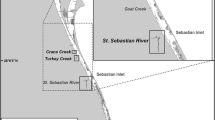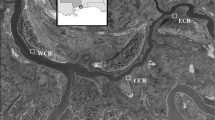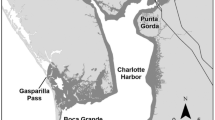Abstract
Subtidal habitats of pipeline canals in Louisiana brackish and saline marshes were sampled seasonally (fall, spring, and summer) between October 1991 and March 1993 with a 2-m2 throw trap to identify dominant natant species and test hypotheses relating habitat selection to water depth. Densities of nekton were compared among canals and between shallow (<1 m) and deep (>-1m) areas within canals to test two null hypotheses: H1: Densities of nekton in pipeline canals are not related to maximum canal depth and H2: Densities of nekton in shallow and deep subtidal areas of canals are equal. Daggerblade grass shrimpPalaemonetes pugio, bay anchovyAnchoa mitchilli, blue crabCallinectes sapidus, brown shrimpPenaeous aztecus, and gulf menhadenBrevoortia patronus numericallly dominated nekton assemblages in both brackish and saline canals. Naked gobyGobiosomabosc, rainwater killifishLucania parva, and gulf pipefishSyngnathus scovelli were dominant only in brackish canals, whereas white shrimpPelaeus setiferus and Atlantic croakerMicropogonias undulatus were abundant in saline canals only. Although variation in the abundance of most numerically dominant species could not be related to maximum canal depth, the distribution of several species within pipeline canals was influenced by habitat depth and other interrelated factors. The degree of habitat segregation with depth was largely influenced by submerged aquatic vegetation (SAV) and salinity as well as water depth. Habitat segregation with depth was most pronounced in brackish canals during late spring (May) when SAV was present. Naked goby, rainwater killifish, blue crabs, and daggerblade grass shrimp were significantly more abundant in shallow water (<1 m) at this time. In saline canals, most blue crabs and daggerblade grass shrimp occupied shallow habitats in March when small juveniles of these species reached peak abundance. Bay anchovy exhibited a pattern opposite that of other species. In March, bay anchovy abundance was positively related to maximum canal depth in brackish canals, and densities were greater in deep than shallow areas of saline canals in June. Salinity may have affected the distribution of freshwater species (e.g., centrarchids) and limited their occurrence in saline canals. Increasing shallow subtidal habitat by backfilling canals may enhance the nursery habitat for some species, especially in brackish canals where the area of subtidal habitat capable of supporting SAV would be expanded.
Similar content being viewed by others
Literature Cited
Abacus Concepts. 1989. SuperANOVA. Abacus Concepts, Inc. Berkeley, CA, USA.
Abernethy, R. and J. G. Gosselink. 1988. Environmental conditions of a backfilled pipeline canal four years after construction. Wetlands 8:109–121.
Adkins, G. and P. Bowman. 1976. A study of the fauna in dredged canals of coastal Louisiana. Louisiana Wildlife and Fisheries Commission Technical Bulletin 18, New Orleans, LA, USA.
Baltz, D. M., C. Rakocinski, and J. W. Fleeger. 1993. Microhabitat use by marsh-edge fishes in a Louisiana estuary. Environmental Biology of Fishes 36:109–126.
Baumann, R. H. and R. E. Turner. 1990. Direct impacts of outer continental shelf activities on wetland loss in the central Gulf of Mexico. Environmental Geology and Water Resources 15:189–198.
Chabreck, R. H. 1971. Ponds and lakes of the Louisiana coastal marshes and their value to fish and wildlife. Proceedings of the Southeastern Association of Game and Fish Commissioners 25: 206–215.
Chabreck, R. H. and G. Linscombe. 1978. Vegetative-type map of the Louisiana coastal marshes. Louisiana Department of Wildlife and Fisheries, New Orleans, LA, USA.
Chabreck, R. H. and A. W. Palmisano, 1973. The effects of Hurricane Camille on the marshes of the Missipsippi River delta. Ecology 54:1118–1123.
Fredette, T. J., R. J. Diaz, J. van Montfrans, and R. J. Orth. 1990. Secondary production within a seagrass bed (Zostera mariana andRuppia maritima) in lower Chesapeake Bay. Estuaries 13:431–440.
Freeman, B. J., H. S. Greening, and J. D. Oliver. 1984. Comparison of three methods for sampling fishes and macroinvertebrates in a vegetated freshwater wetland. Journal of Freshwater Ecology 2:603–609.
Green, R. H. 1979. Sampling Design and Statistical Methods for Environmental Biologists. John Wiley and Sons, New York, NY. USA.
Hettler, W. F. 1989. Nekton use of regularly-flooded saltmarsh cordgrass habitat in North Carolina, USA. Marine Ecology Progress Series 56:111–118.
Hoese, H. K. and R. H. Moore. 1977. Fishes of the Gulf of Mexico, Texas Louisiana and Adjacent Waters. Texas A&M University Press, College Station, TX, USA.
Kneib, R. T. 1991. Flume weir for quantitative collection of nekton from vegetated intertidal habitats. Marine Ecology Progress Series 75:29–38
Loesch, H. 1965. Distribution and growth of penaeid shrimp in Mobile Bay, Alabama. Publications of the Institute of Marine Science 10:41–58.
Lubbers, L., W. R. Boynton, and W. M. Kemp. 1990. Variations in structure of estuarine fish communities in relation to abundance of submersed vascular plants. Marine Ecology Progress Series 65: 1–14.
McIvor, C. C. and W. E. Odum. 1988. Food. predation risks and microhabitat selection in a marsh fish assemblage. Ecology 69: 1341–1351.
Mock, C. R. 1966. Natural and altered estuarine habitats of penaeid shrimp. Proceedings of the Gulf and Caribbean Fishery Institute 19:86–98.
Neill, C. and R. E. Turner. 1987a. Backfilling canals to mitigate wetland dredging in Louisiana coastal marshes. Environmental Management 11: 823–836.
Neill, C. and R. E. Turner. 1987b. Comparison of fish communities in open and plugged backfilled canals in Louisiana coastal marshes. North American Journal of Fisheries Management 7:57–62.
Norusis, M. J. 1990. SPSS Advanced Statistics User’s Guide. SPSS Inc., Chicago, IL, USA.
Orlando, S. P., Jr., L. P. Rozas, G. H. Ward, and C. J. Klein. 1993. Salinity characteristics of Gulf of Mexico estuaries. NOAA Office of Ocean Resources Conservation and Assessment, Silver Spring, MD, USA.
Peterson, G. W. and R. E. Turner. 1994. The value of salt marsh edge vs interior as a habitat for fish and decapod crustaceans in a Louisiana tidal marsh. Estuaries 17:235–262.
Reed, D. J. and L. P. Rozas. 1994. Potential for enhancement of fisheries habitat by infilling OCS pipeline canals. OCS Report/MMS 93-0061. U.S. Department of Interior, Minerals Management Service, Gulf of Mexico OCS Regional Office, New Orleans, LA, USA.
Rice, W. R. 1989. Analyzing tables of statistical tests. Evolution 43:223–225.
Rozas, L. P. 1992. Comparison of nekton habitats associated with pipeline canals and natural channels in Louisiana salt marshes. Wetlands 12:136–146.
Rozas, L. P. 1993. Nekton use of salt marshes of the southeast region of the United States. p. 528–537.In O. T. Magoon, W. S. Wilson, H. Converse, and L. T. Tobin (eds.) Proceedings of the Eighth Symposium on Coastal and Ocean Management. Coastal Zone ’93 Conference. American Society of Civil Engineers, New York, NY, USA.
Rozas, L. P. and W. E. Odum. 1987. Fish and macrocrustacean use of submerged plant beds in tidal freshwater marsh creeks. Marine Ecology Progress Series 38:101–108.
Rozas, L. P. and W. E. Odum. 1988. Occupation of submerged aquatic vegetation by fishes: testing the roles of food and refuge. Oecologia 77:101–106.
Rozas, L. P., and D. J. Reed. 1993. Nekton use of marsh-surface habitats in Louisiana (USA) deltaic salt marshes undergoing submergence. Marine Ecology Progress Series 96:147–157.
Ruiz, G. M., A. H. Hines, and M. H. Posey. 1993. Shallow water as a refuge habitat for fish and crustaceans in non-vegetated estuaries: an example from Chesapeake Bay. Marine Ecology Progress Series 99:1–16.
Schlosser, I. J. 1987. The role of predation in age- and size-related habitat use by stream fishes. Ecology 68:651–659.
Shirzad, F. F., C. J. Klein, III, and S. P. Orlando, Jr. 1989. Revised physical and hydrologic characteristics for the Mississippi Delta Region estuaries. NOAA National Ocean Service. Rockville, MD, USA.
Tabberer, D. K., W. Hagg, M. Coquat, and C. L. Cordes. 1985. Pipeline impacts on wetlands. Final environmental assessment. OCS EIS/EA 85-0092. Minerals Management Service, New Orleans, LA, USA.
Thompson, B. A. and W. Forman. 1987. Nekton. p. 80–95.In W. H. Conner and J. W. Day, Jr. (eds). The ecology of Barataria Basin, Louisiana: an estuarine profile. U.S. Fish and Wildlife Service, Biological Services Program, Washington, DC, USA. Biology Report. 85 (7.13).
Turner, R. E., E. M. Swenson, and J. M. Lee. 1994. A rationale for coastal wetland restoration through spoil bank management in Louisiana, USA. Environmental Management 18:271–282.
Weaver, J. E. and L. F. Holloway. 1974. Community structure of fishes and maerocrustaceans in ponds of a Louisiana-tidal marsh influenced by weirs. Contributions in Marine Science 18:57–69.
Wicker, K. M., R. E. Emmer, D. Roberts, and J. van Beek. 1989. Pipelines, navigation channels, and facilities in sensitive coastal habitats, an analysis of outer continental shelf impacts, coastal Gulf of Mexico. Vol. I: technical narrative. OCS Report/MMS 89-0051. U.S. Department of Interior, Mirerals Management Service, Gulf of Mexico OCS Regional Office, New Orleans, LA, USA.
Zimmerman, R. J., T. J. Minello, and G. Zamora, Jr. 1984. Selection of vegetated habitat by brown shrimp,Penaeus aztecus, in a Galveston Bay salt marsh. Fishery Bulletin 82:325–336.
Author information
Authors and Affiliations
Rights and permissions
About this article
Cite this article
Rozas, L.P., Reed, D.J. Comparing nekton assemblages of subtidal habitats in pipeline canals traversing brackish and saline marshes in coastal Louisiana. Wetlands 14, 262–275 (1994). https://doi.org/10.1007/BF03160632
Received:
Revised:
Issue Date:
DOI: https://doi.org/10.1007/BF03160632




